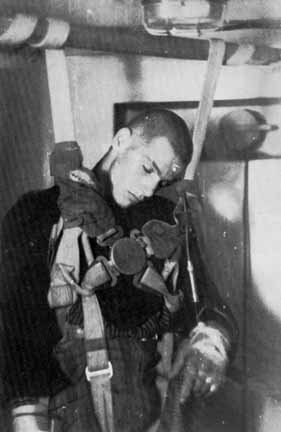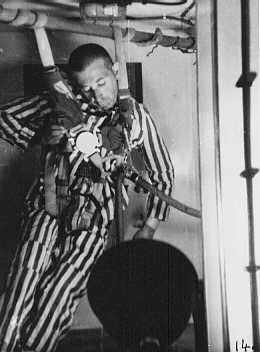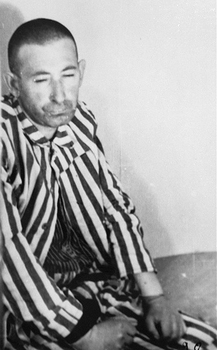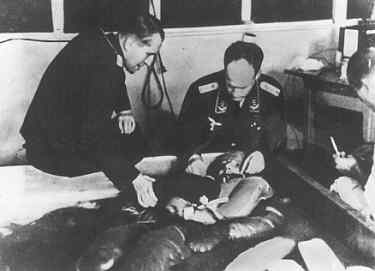Medical Experiments at Dachau

Medical experiments
were done for German Air Force
Among the worst atrocities committed
at the infamous Dachau concentration camp were the cruel and
inhumane medical experiments, using prisoners as guinea pigs,
conducted by Dr. Sigmund Rascher for the benefit of the Luftwaffe,
the German Air Force. From March 1942 until August 1942, Dr.
Rascher performed high altitude experiments under the authority
of Reichsführer-SS Heinrich Himmler. The Nazi justification
for these experiments was that this was done in an effort to
save the lives of German pilots.
The most disturbing picture of the medical
experiments, performed by Dr. Sigmund Rascher, that I first saw
in the Dachau Museum in May 1997, and the one that I can't get
out of my mind, is shown in the photograph above. The prisoner
looks like an American, but the caption on the photo identified
him as Russian. He is wearing the parachute harness of a German
Air Force pilot, which is very similar to an American pilot's
parachute harness.
In 1942, the American government did
similar high altitude experiments for the US Air Force. According
to a book entitled "Lindbergh" by A. Scott Berg, these
experiments began on September 22, 1942 when Charles Lindbergh
and six of his colleagues flew to Rochester, Minnesota where
they met Dr. Walter M. Boothby, a pioneer in aviation medicine,
who was the chairman of the Aeromedical Unit for Research in
Aviation Medicine at the Mayo Clinic. Their mission was to study
the medical problems associated with high altitude flying. For
the next ten days, Lindbergh himself became a human guinea pig,
according to Berg's book. After the conquest of Germany, the
American government confiscated the results of Dr. Rascher's
tests and made use of his experiments for the US Air Force.
 Prisoner subjected
to high altitude experiment
Prisoner subjected
to high altitude experiment
 Prisoner after high
altitude experiment
Prisoner after high
altitude experiment
The two photos above were shown in the
Dachau Museum exhibits when I first visited Dachau in May 1997.
The subject is wearing a striped prison uniform. An autopsy was
performed on the brains of the victims who died during the experiments.
Much of the information about the Dachau
medical experiments comes from the testimony of Walter Neff who
was a prisoner in Dachau. Neff worked as an assistant to Dr.
Sigmund Rascher in the camp; after he was released from Dachau,
Neff continued to work for Dr. Rascher inside the camp.
According to Neff, medical experiments
were conducted on 180 to 200 prisoners. He testified during the
Nuremberg Doctors Trial that 10 of these prisoners were volunteers,
and that most of the other prisoners, with the exception of about
40, had been condemned to death by German courts. The other 40
subjects were Russian POWs who were brought to Dachau because
they were believed to be Communist Commissars. Just before the
invasion of the Soviet Union in June 1941, Adolf Hitler had issued
an order that all captured Communist Commissars were to be executed.
During the course of the medical experiments,
70 to 80 prisoners died, according to Neff. This information
regarding Neff's testimony comes from a book entitled "Dachau
1933 - 1945: The Official History," written by a prisoner
in the camp named Paul Berben. Berben does not mention how many
of the 70 to 80 prisoners that died had already been condemned
to death.
At their trial, the Nazi Doctors attempted
to defend these experiments by claiming that the prisoners who
were forced to participate in the experiments were men who had
volunteered or had been condemned to death. However, Martin Gottfried
Weiss, who was the Commandant at Dachau when the experiments
took place, told American interrogators that the subjects of
the experiments were "professional criminals" or "career
criminals" who had not been condemned to death.
On June 17, 1936, Adolf Hitler had signed
a decree which made Reichsführer-SS Heinrich Himmler the
new Chief of the German Police within the Reich Ministry of Interior.
According to Peter Padfield, author of the book "Himmler,"
the new Police Chief "saw his task as preventing crime before
it happened by shutting away habitual criminals, preserving the
Volk from contamination by shutting away subversives who might
corrupt them, picking up vagrants, the 'work shy' and 'anti-socials'
and putting them to work in his camps, and in addition supervising
public morals."
Padfield wrote that Himmler's first large-scale
action as Police Chief was the "nationwide round-up of professional
criminals." On March 9, 1937, Himmler gave the order to
arrest around 2,000 "professional criminals" who had
committed two or more crimes, but were now free after having
served their sentences. They were arrested without charges and
sent to a concentration camp for an indeterminate time.
The main category of prisoners in all
the camps in Germany were the Schutzhäftling or prisoners
in "protective custody." These prisoners were political
dissidents who had been arrested, but not charged with any crime.
They were sent to the camps for the purpose of political indoctrination.
Reichsführer-SS Heinrich Himmler wanted the concentration
camps to be primarily re-education centers, where the prisoners
would be given courses that would result in lasting conversions.
At least one Jew, a former delicatessen
clerk, died in the Dachau medical experiments, as Dr. Rascher
noted in a letter to Heinrich Himmler, detailing the results
of an autopsy. Dr. Rascher described the victim as a condemned
criminal who had violated the laws against race mixing. According
to Peter Padfield, who wrote a book entitled "Himmler,"
Dr. Rascher participated in his own experiments as a subject,
but unlike the prisoners, he had the option of stopping the experiment
at any time.
Neff worked with Dr. Rascher from the
beginning of 1941. He was released from camp custody as a prisoner,
on the condition that he continue working with the Doctors. Berben
wrote that Neff would regularly report for duty in uniform, and
carried a pistol in the camp. Neff testified that he worked in
the interest of the prisoners and attempted to sabotage the work
of Dr. Rascher. According to Berben's book, Neff's "role
in his dealings with Rascher never seems to be very clear, nor
the part he played in choosing the subjects for experiments."
Neff also participated, along with other
prisoners who had been released or had escaped from the camp,
in the uprising in the town of Dachau a few days before the American
forces arrived.
According to Peter Padfield, "After
the high-altitude experiments had been completed the previous
spring, the Luftwaffe had requested another series of experiments
to throw light on the problems of reviving aircrew shot down
over the sea."
Padfield wrote that the formal proposal
came from Generalfeldmarschall Milch in a letter to Karl Wolff
dated 20 May 1942. After Himmler gave his approval, these new
experiments began in August 1942. The subject was immersed in
a chamber of ice cold water, dressed in a full flying outfit
complete with a life jacket. It took up to an hour and a half
for the subjects' temperature to fall to 29.5 degrees and body
temperature continued to fall after the subjects were removed
from the water.
From these experiments, it was learned
that death occurred only among those subjects who were wearing
life jackets that allowed the back of the neck to be immersed
in the water. In a report submitted on 10 September 1942, Rascher
said that another major finding was that rapid rewarming in a
hot bath was more effective than slow rewarming with blankets
or by other means. Rewarming by animal warmth, or by the use
of women's bodies, was found to be too slow. Dr. Rascher was
not keen on using women to warm up the subjects, but Himmler
insisted on testing this method, according to Padfield's book.
Another experiment was done to test rewarming
of subjects exposed to dry cold. In a letter 17 February 1943,
Dr. Rascher wrote:
Up to the present I have carried out
intense chilling experiments on thirty human beings by leaving
them outside naked from nine to fourteen hours, thereby reducing
their body temperature to 27-29 degrees. After an interval which
was supposed to correspond to a period of transport lasting one
hour, I placed these experimental subjects in a hot bath. In
all experiments to date all subjects were successfully rewarmed
within another hour despite the fact that their hands and feet
were partly frozen white .... No fatalities occurred as a result
of extraordinarily rapid method of rewarming.....
The following quote is from Berben's
book:
The most terrible experiment at which
Neff was present was one carried out on two Russian officers.
They were taken from the Bunker and plunged naked into a tank
[of freezing water] at about 4 p.m., and they held out for almost
five hours. Rascher had leveled his revolver at Neff and a young
Polish aide who tried to give the two wretches chloroform. Dr.
Romberg considered the whole episode as described by Neff during
the trial to be improbable; in his view, the subject of such
experiments is stiff and incapable of making a movement or uttering
a word after 10 or 20 minutes, whereas, according to Neff, the
two officers were still talking to one another during the third
hour and bade each other farewell.
 Dr. Rascher (on the
right) conducting a freezing experiment
Dr. Rascher (on the
right) conducting a freezing experiment
Dr. Hans Wolfgang Romberg, who is mentioned
in the quote above, was put on trial at Nuremberg in the Doctors
Trial which started on December 9, 1946 and ended on August 20,
1947. Dr. Romberg was acquitted, as were Dr. Siegfried Ruff and
Dr. August Weltz who were also involved in the Luftwaffe experiments
at Dachau.
Dr. Rudolf Brandt, who selected the victims
for the Luftwaffe experiments, and Dr. Wolfram Sievers, who observed
the experiments, were also put on trial at Nuremberg in the Doctors
trial. They were both convicted, but not for anything they did
during the experiments at Dachau. Brandt and Sievers were both
hanged on June 2, 1948.
Dr. Rascher was given his assignment
to do the Luftwaffe experiments by Reichsführer-SS Heinrich
Himmler after Frau Nini Rascher, who was a very good friend of
Himmler, recommended him. Nini Rascher was older than her husband,
as was Frau Himmler and both were past child-bearing age when
Dr. Rascher claimed that his wife had borne two children. When
it was discovered that the children were actually orphans that
Dr. Rascher had illegally adopted, Dr. and Frau Rascher were
both arrested and imprisoned in a Munich jail.
Dr. Leo Alexander, a native of Austria
who fled to China and then to America when the Nazis came to
power, worked as an investigator for the prosecution in the War
Crimes Commission at Nuremberg from 1946 to 1947, gathering information
for the Nuremberg Doctor's Trial. Dr. Alexander's papers are
kept in the Guide to the 65th General Hospital Collection in
the Archives and Memorabilia Department at Duke University Medical
Center in Durham, North Carolina.
Dr. Alexander's report on the Prolonged
Exposure to Cold evaluated the Nazi hypothermia experiments conducted
by Dr. Rascher at Dachau; he found inconsistencies in Dr. Rascher's
lab notes which led him to believe that Dr. Rascher had deceived
Himmler about his results. According to Dr. Alexander, Rascher
reported to Himmler that it took from 53 minutes to 100 minutes
for the prisoners to die in the freezing water. However, Dr.
Alexander's inspection of Dr. Rascher's personal lab notes revealed
that some of the subjects had suffered from 80 minutes to five
or six hours before they died. According to Dr. Alexander, Himmler
discovered that Dr. Rascher had lied in his reports and Dr. Rascher's
deception was the reason that Himmler ordered the execution of
both Dr. Rascher and his wife in April 1945.
This page was last updated on February
27, 2009
|